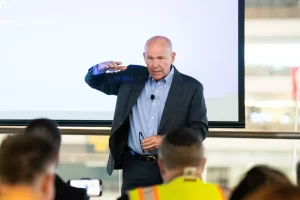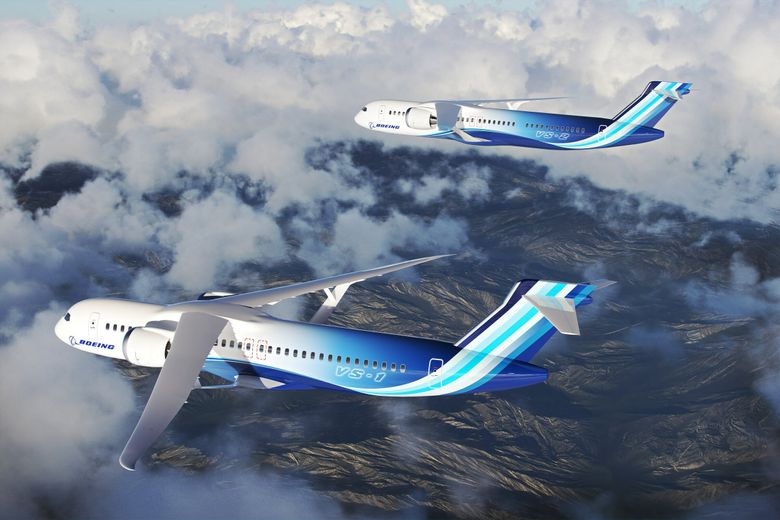By
 Ahead of the Paris Air Show later this month, Boeing CEO Dave Calhoun this week expressed confidence in the jetmaker’s path to recovery and its ability to catch up with rival Airbus.
Ahead of the Paris Air Show later this month, Boeing CEO Dave Calhoun this week expressed confidence in the jetmaker’s path to recovery and its ability to catch up with rival Airbus.
Speaking in North Charleston, South Carolina, he also made comments about Boeing’s next all-new airplane that suggest a radical technology shift.
He said a new airframe configuration being developed with NASA that would give the jet a different look from current airliners could be ready to use in the mid-2030s.
“We think we have a real shot at bringing that technology to bear on the next airplane,” said Calhoun.
As he traced out Boeing’s future trajectory, Calhoun described a comeback from the two existential crises it faced when he became CEO in 2020: the devastating impact of the two deadly 737 MAX crashes, and the unprecedented collapse of air travel from the COVID-19 pandemic.
Since then, Boeing has stumbled through repeated production setbacks. And yet, deliveries of the Washington-built MAX and the South Carolina-built 787 Dreamliner — its two major cash-generating jet programs — are slowly ramping up again.
Boeing is preparing a MAX assembly line in Everett to complement the three in Renton. And in North Charleston, it now plans a second assembly line to allow production to ramp up to 10 planes per month.
“It speaks to the legacy of our company, our people, their commitment, dedication,” Calhoun said of the MAX’s recovery in Renton. “You have to get tested every now and then. I wish it wasn’t that way. But I think we’ve so far passed that test.”
He praised the South Carolina workforce for how they are working through the fixes for the quality problems that stopped all but a few 787 deliveries from the fall of 2020 through summer 2022, with further less-severe glitches this year.
“They’ve been through a lot, they’ve seen ups and downs. They are back on an up,” Calhoun said.
In the aftermath of the global pandemic business downturn, Calhoun said both Airbus and Boeing are benefiting from a scarcity market, in which demand for air travel and so for airplanes is surging while parts supply constraints hold back production.
He said he believes airline demand will outstrip the number of jets either manufacturer can build probably for the next five or six years.
“It’s an interesting moment in time,” Calhoun said. “I never imagined the industry could bounce back as fast as it has.”
And while he reiterated that Boeing won’t deliver its next all-new airplane until the mid-2030s, he said research into the key technologies that could be on that jet is already under way.
“There’s a lot of homework going on, a lot of regular testing,” Calhoun said.
Rivalries with Airbus and China
With the Paris Air Show, the aviation world’s premier global showcase, opening June 19, Calhoun offered journalists from around the world a rare opportunity to ask him questions at a series of pre-Paris briefings.
One focus was the industry’s continued supply chain problems, affecting both Airbus and Boeing.
Most recently, supplier Spirit AeroSystems of Wichita, Kan., discovered a quality defect with its manufacturing of the 737 MAX’s vertical tail fin that predated the pandemic and affects hundreds of jets.
Boeing estimates it will take until the end of next month to fix just the undelivered planes. Key airlines are getting fewer MAXs than they planned for during the peak summer season.
That’s just the latest of a litany of setbacks, many attributed to a lack of workers at key suppliers after the pandemic.
Calhoun said the impact of the pandemic on Boeing’s “very large, very fragmented supply chain” was exacerbated by the aging aviation manufacturing workforce.
When business collapsed, companies laid off thousands of workers and others chose to retire. When business returned, many didn’t come back.
The demographics “lean against us,” Calhoun said. “It’s skills, it’s talent, it’s experience, it’s people. This is where everybody is struggling.”
“We have to help them get their workforces back to where they were,” he added. “We’ve got a lot of wrestling matches with a lot of our supply chain to get to where we need to be.”
Calhoun said “slowly, steadily, these supply chains are rebuilding themselves,” but warned that Boeing production rates will probably remain constrained by parts shortages through next year.
On the competition from Airbus, Calhoun acknowledged that Boeing’s market share in the high-volume market for single-aisle jets used on domestic and regional routes has slipped to around 40% — and that Boeing “will never make up” the gap between the MAX and the A320neo.
But he said the market share loss is simply down to the long grounding of the MAX and the stoppage on 787 deliveries.
“We couldn’t deliver airplanes,” Calhoun said. “We still have a hangover from not being able to deliver airplanes.”
That hangover is what he called “a shadow factory,” referring to the Boeing mechanics in Everett and North Charleston who instead of working to build new planes are restoring parked MAXs and 787, readying them for long-delayed delivery.
He said that work takes as long for each plane as assembling a new one.
But he denied that Boeing is disadvantaged against Airbus going forward. Both the MAX and the 787 are now selling extremely well.
Likewise, Calhoun urged calm about the threat of competition from China, which he acknowledged is a growing power in aviation.
On Sunday, the C919 single-aisle jet developed by the Commercial Aircraft Corp. of China finally made its first commercial flight with passengers from Shanghai to Beijing.
The C919 “is a good airplane,” Calhoun said. But he said Airbus and Boeing will each keep investing in new technology to stay ahead.
“The good news for everybody is that three providers in a growing global market of this size and scale should not be the most intimidating thought in the world,” he said.
Calhoun added that despite the political tensions between China and the U.S., he expects Boeing sales there “will move forward in a more constructive fashion with fits and starts.”

New airplane concepts
Calhoun defended his controversial decision not to launch an all-new airplane for this decade — despite Boeing’s lagging single-aisle market share.
He asserted that to justify the investment, any new jet development program must incorporate radically updated technology rather than incremental improvements.
“These programs have to be 50-, 80-, 100-year programs. They can’t be 20 years,” he said. “You’d never get a return.”
He declared as definitively dead Boeing’s previously mooted concept that was dubbed the Middle of the Market airplane and intended to fill the size gap between the narrowbody 737 MAX and the widebody 787 where Airbus has its biggest advantage.
“We’re not going back to whatever that design was,” Calhoun said, dismissively. “I’ve never even looked at it.”
Instead, he talked up Boeing’s collaboration with NASA on a new airplane concept called the Transonic Truss-Braced Wing.
Though many in the industry think this a far-out design, Calhoun said it’s advanced enough to potentially be ready to use on Boeing’s next all-new jet.
This airplane configuration features a high, thin and extra-long wing that will support larger engines. The wing is attached to the top of the fuselage and braced by a truss from the bottom of the fuselage.
Positioning the concept as a significant move toward sustainability, NASA said the Transonic Truss-Braced Wing design, combined with expected engine, systems and materials advancements, could reduce fuel consumption and carbon emissions by up to 30% compared with today’s Boeing 737 MAXs and Airbus A320neos.
Following wind-tunnel work with small-scale models, in January NASA selected Boeing for the next phase of the project: to develop, build and flight-test a full-scale demonstrator airplane.
Calhoun said he looks forward to “now putting it on a real airplane, watching it fly. And hopefully, by 2028, proving to ourselves that it can actually do the job.”
He added that Boeing is researching other technologies likely also to be mature enough for the next all-new airplane. He mentioned advanced composite materials as one.
And he said Boeing hopes to make flight controls on the next airplane “as close to autonomous as we can conceivably get at that stage.”
Separately during the pre-Paris briefings, Brian Yutko — a former Boeing vice president in charge of air mobility and now CEO of Boeing-backed air taxi venture Wisk — announced that Boeing has bought out the other owner, KittyHawk, and taken full control of Wisk.
What makes Wisk different from other air taxi concepts is the plan to operate without a pilot. Passengers climb in and the latest four-seater model is designed to take off and fly autonomously.
It’s this technology that Boeing is most interested in owning.
Regaining public trust
With entry into service of that next all-new airplane more than a decade away, Boeing’s daily focus must be on fixing its current problems.
Aside from handling the supply chain glitches, there is also the matter of rebuilding trust with the public following the MAX accidents.
Calling that crisis “self-inflicted,” Calhoun said it “never should have occurred.”
“But it happened. So we deal with it,” he added. “We move forward. And we admit to it.”
Since the grounding of the MAX was lifted in late 2020, there are now more than 1,000 MAXs in service that have safely flown 1.7 million flights. Yet Calhoun said he accepts that some travelers may still be reluctant to fly on a MAX.
He said Boeing can rebuild trust only by ensuring that “every next airplane, has to be perfect, has to meet the reliability standards, has to meet those safety standards.”
“We win this one airplane at a time,” he said. “And we’re not done.”
